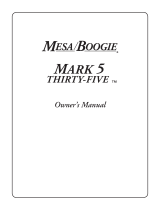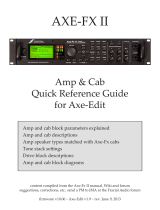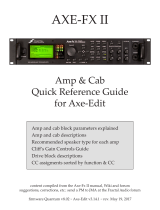
PAGE 5
CHANNEL MODES: (Continued)
CHANNEL 3 is optimized for the legendary MODERN mode with a range of PRESENCE far exceeding that of CHANNEL 2. This
channels’ PRESENCE picks up where CHANNEL 2 leaves off and allows top end harmonics that are downright dangerous. The trade
off here is that for VINTAGE and RAW the PRESENCE is hyperactive and must be dialed with care to achieve the more warm and round
sounds. You can think of it like this...a Presence setting equivalent to CHANNEL 2’s PRESENCE Control set to 5:30 (maximum), is
found in CHANNEL 3 at approximately 10:00 on CHANNEL 3’s PRESENCE Control. This means that the whole range is compressed
for these more vocal sounds and the resolution for brighter sounds is expanded.
The difference in these PRESENCE Controls produces a wonderful difference in the Channels and makes it possible to fine tune any
of the modes to your liking. You might want two versions of RAW, one set warmer for purring blues sounds and the other set brighter
for either soft clip, almost clean chording or stinging solo jabs. Or, you might need two MODERN modes...a super tight aggressive
sound for grinding rhythm and a rolled off, compressed version for bold, but authoritative solo work. The differences create limitless
possibilities for expression and we encourage you to learn these two PRESENCE Controls and keep in mind their response as you
dedicate your channels and divide up their responsibilities.
If you come to find that you are mostly using two sounds of the same type in the same Mode in Channels 2 and 3 (both 2 & 3 set to
VINTAGE or both 2 & 3 set to MODERN) and this difference in Presence pots is making it difficult to dial in your sounds, it is possible
to change out either channels PRESENCE Control to be the value and taper of the Channel you prefer. This will omit the differences
and create two virtually identical channels. You can call us and ask to speak with a Product Specialist. Tell us which channel you wish
to duplicate and the correct PRESENCE Control pot can be sent to you for a nominal charge. If you do not feel comfortable doing this
mod yourself or trust anyone in your area, you can obtain a Return Authorization from our Customer Service Dept. and send your
amplifier to us to perform the mod for the minimum bench charge. You will be responsible for shipping charges both ways and
to pack the unit so that it is safe from shipping damages.
This new Recto mode is the lowest gain of the three in the two high gain lead channels. Its less saturated nature greatly
enhances the already versatile bevy of sounds the two original lead channels offered. The range of gain available covers an extremely
wide spectrum and it can be set to double as a formidable alternate clean mode, a low gain purring blues sound and beyond, all the
way up to a grinding crunch or searing solo sound. The TREBLE can be set relatively high (2:00) to add a little more gain and shred
when using RAW for certain crunch rhythm sounds and keep in mind CHANNEL 3 is capable of more aggressive sounds due to
its more extreme PRESENCE Control taper. Don’t overlook the amazing medium gain soloing potential RAW offers in CHANNEL
2 where, because of the PRESENCE Controls more gradual response, a wider range of voice-like single note sounds appear that
benefit from this more compressed character.
This high gain mode is the famous liquid Recto voice and it can be found in its original state in CHANNEL 2. Its lush
harmonic content and fat creamy feel has found its way onto so many recordings, it is now a staple for anyone headed to the studio
for an album project. Combining this super juicy, expressive preamp with the Rectos’ black magic, tube-rectified power section creates
colors in gain that most players find truly addictive. Single note solo work is effortless as the strings become easy to play with
VINTAGE modes musical and natural tube compression. Spend time learning the lower regions of the VINTAGE mode as the overlap
between RAW and VINTAGE is a place where many beautiful sounds lie. These two modes are similar enough when VINTAGE is
set in its lower range and RAW is set in its medium to higher range and yet, each posses a character that is unique and identifiable.
Remember that you can swap channels to achieve different voicings of the VINTAGE sound and no matter which you settle upon,
you will likely find your trademark lead sound lurking somewhere in this sea of liquid gain.
Aggressive. This is the word that best describes the menacing power of the Rectos’ most rebellious of all modes and
appears in its original form in CHANNEL 3. A take no prisoners, crushing assault of top end cut and lightning fast response creates
a sound of unparalleled aggression that has set a new standard for hard core sounds. The added tightness of the low end response
combined with the radically more present top end keeps the MODERN mode tracking accurately even at extreme gain settings. Keep
in mind that when using MODERN in CHANNEL 2 you will have to run the PRESENCE Control almost all the way up to approach
the lower range of the PRESENCE Control in CHANNEL 3. This lack of extreme top end can be a benefit when searching for single
note solo sounds in the MODERN mode as the more compressed nature of this tamer presence range in CHANNEL 2 tends to warm
things up.

























